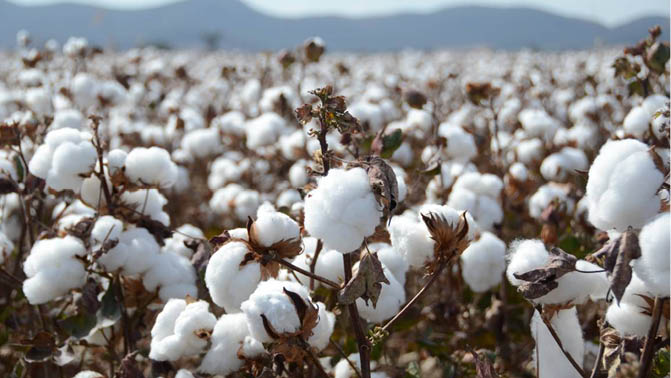In the last two years, cotton production has been gathering momentum, but the challenges of farmers have remained unsolved.
Cotton farmers in Nigeria are mostly smallholders, with production largely through the rain-fed system, using traditional farm tools and animal traction (animal drawn implements). However, few now have access to tractors.
In the 1980s, cotton was grown by about 900,000 smallholder farmers, holding an average of 0.5 to 1.5 hectares in an estimated total area of about 700,000 hectares across the country.
However, with the collapse of the textile and garment industries, as well as poor market, most of the farmers abandoned production for other crops with better market potentials.
Current production level
The annual demand of cotton in Nigeria is estimated at 88,000 metric tonnes of lint, which is about 255,000 metric tonnes of seed cotton.
Until 2019, the total domestic production was below 60,000 with many farmers struggling even to achieve the average yield of between 400kg and 750kg of seed cotton per hectare despite the fact that some of the seeds have yield prospects of about 2.5 to 3.0 metric tonnes per hectare.
Statistics from the National Cotton Association of Nigeria (NACOTAN) showed that the number of farmers under the association has grown from 90,000 in 2018 to about 134,000 farmers for the 2020 wet season.

In 2019, the farmers achieved 120,000 to 130,000 tonnes, which amounts to about 80,000 metric tonnes increase. For this 2020 wet season, production was expected to reach 200,000 metric tonnes, according to NACOTAN.
The current market
A farmer, Bala Sarkin Ruwa in Shelleng, Adamawa State, told Daily Trust on Sunday that he sold the 2 tons of his cotton early at N180,000. But his counterpart, Mr Joshua Dadi said he sold at N200,000 in January 2021, describing the price as fair.
Mr Anibe Achimugu, national president of the NACOTAN and managing director of the Arewa Cotton, described the current prices as good for the farmers, compared to previous years.
“In 2019, the price per tonne was N205,000 for farmers. That means a farmer was doing over a N100,000 profits directly into the pocket if he was able to produce 2 tonnes of seed cotton.
“The intervention is such that the Central Bank of Nigeria (CBN) wants to jump-start the sector. And of course, you want to leave it, to a large extend, at market-driven prices and demand. Now, the minimum price, at least this year, is N185,000 per metric tonne, which is still better than if it was to be left on its own and not encouraging to farmers, and so on, where prices were N140 to N150,000 per metric tonne. I think the minimum guaranteed price since the intervention has been good,” he said.
Issue of quality seed
Professor Ishiyaku Mohammed, the executive director of the Institute of Agricultural Research, Ahmadu Bello University, Zaria, said the institute had released13 different varieties of cotton seeds with very important economic attributes that increase the income of farmers and provide different products for utilisation, either as fiber or for making textile products, or even for providing oil.
The farmers said that last year, there was an improved access to better quality seeds, with a potential yield of 2.5 tonne per hectare if the best agronomic practices were followed.
With that, Achimugu said “a farmer was jumping in yield figure of between 400 to 500 kilogrammes per hectare to 1.2, 1.5, and in fact, some were getting the 2.5 tonne per hectare. You know it is how well you manage your farm, the dedication and skill you have, but I will tell you specifically that perhaps the lowest that was recorded was around 700 to 750kg per hectare. But farmers were hitting 1.5 to 2.5 tonnes per hectare, which was fantastic.”
In 2018, the federal government, through the National Varietal Release and Naming Committee, approved the commercialisation of two transgenic cotton varieties, MRC 7377 BG 11 and MRC 7361 BG II developed by Mahyco Nigeria Private Ltd, in collaboration with the Institute for Agricultural Research (IAR) in the Ahmadu Bello University, Zaria.
Resuscitating cotton industry, a lifeline
Cotton is the key component of the textile and garment industries because it provides fibre for the manufacturing of textile products. However, the faith of the nation’s textile industries had gone down to a pulp for decades since the glorious years.
In the 1970s to the 1990s, the Nigerian textile industry accounted for about 25 per cent of the Manufacturing Value Added (MVA). It used to be the largest employer of labour (more than 600,000 people during the 1970’s to 1980’s) in the manufacturing sector after public sector in the early 1990s.
However, experts hinged the collapse of the textile industries that made Kaduna a household name in the country on the high operating cost, resulting from poor energy supply, infrastructure decay and proliferation of the market with cheap and smuggled textiles. This also forced some to relocate to other countries within the sub-region.
Out of the 54 ginneries available in Nigeria, only 22 are functioning at very low capacity utilisation. Ginning capacity of the existing ginneries is about 650,000 tonnes of seed cotton but national production falls to” less than 60,000 tonnes per annum representing about 10 per cent capacity utilisation” according to the data from the Raw Material Research and Development Council (RMRDC).
“This trend has a spirally limiting effect on the cotton value chain development locally, culminating in the folding up of several textile industries (83) between 1995 till date, while the few that are functioning (23) are performing at low capacity utilisation,” Professor Hassaini Ibrahim Doko, the director-general, RMRDC said.
Experts said to bring cotton value chain back to life and its glorious days, the federal government must champion the revival of industries through various policies and financial interventions.
FG must tackle smuggling, cheap import
The Director-General of the Nigerian Textile Manufacturers Association, Alhaji Hamma Kwajaffa, said smuggling and cheap Chinese imports had been the bane of the country’s cotton industry.
Despite the procurement act for local content to be sourced first, nothing has changed much as most of the materials used for uniforms majorly come from China, while others come from India, Bangladesh and Pakistan.
“The original thing should have been that all our uniforms are sourced locally from the textile companies. If you look at our schools, Army, Navy, Air Force, Immigration, Customs etc, if their uniforms were all sourced locally, of course many of the textile industries would not have closed.
“Our problem is actually smuggling. You know our dealers can go to China; and in China, anything you ask for they can do it for you. They go to China with our textile design and the Chinese would do it for them the way they want, and this ends up in Nigerian markets,” Alhaji Kwajaffa lamented.
Cotton farmers, through the NACOTAN, want the federal government to take up cotton as a national asset and introduce a Nigerian standard, which can help the country to have a good grading system, as well as the establishment of high volume instrument cotton testing laboratories, he also said, adding that “these will take care of many issues.”
Banditry affects production
In the last two years, many cotton farmers could not access their farms because of the activities of bandits along major producing areas.
Recently, the only surviving textile company in Kaduna State shut down operations and sacked over 100 staff due to the absence of raw materials because the farmers were complaining that bandits won’t allow them go to their farms.
Stakeholders said government must reinvigorate its security architecture to enable farmers return to their farms as that is the only way to reduce poverty in rural communities.
Abdullahi Salisu Dayi, a farmer in Malumfashi Local Government, said that unless something spectacular happened in favour of cotton production, he doubted if farmers would engage in it as they did last year.
Climate change affecting production
Last year, many cotton farmers in Katsina, Gombe and Adamawa states suffered erratic rainfall, which has affected yields.
Some farmers who spoke with Daily Trust on Sunday in Adamawa, Katsina and Gombe said their yields were severely affected by little or heavy rainfall.
Joshua Dadi in Kem, Adamawa State, said his yield was affected because of a sudden cessation of rainfall. Although he got 4 tonnes in his two-hectare farm, the yield is below the 2019 yield.
Hamisu Sani in Katsina said cotton farmers suffered most as demand for the produce is not like that of rice, maize or soybeans, yet its price is good at N200,000 per tonne. “Heavy rainfalls permeated our cotton farms and stagnated the growth of the crop, as well as caused rot of the cotton balls at their early stage,” he added.
Another large scale cotton farmer, Alhaji Kamilu Kankara, said he also suffered low yield of the produce due to heavy rainfall.
“Over the years, demand for food items has prompted my gradual withdrawal from massive cotton production. This year seems the worst for me as I only harvested nine bags from two hectares that were giving me three tonnes of cotton,’’ he said.
With a growing population of over 200 million and army of unemployed youth roaming the streets, experts said government must give priority to sectors like agriculture huge attention, both in budget, policies and financial interventions.

 Join Daily Trust WhatsApp Community For Quick Access To News and Happenings Around You.
Join Daily Trust WhatsApp Community For Quick Access To News and Happenings Around You.


